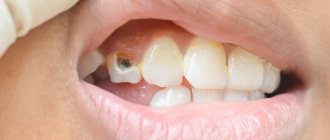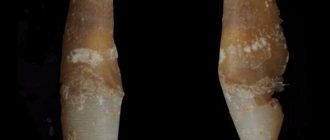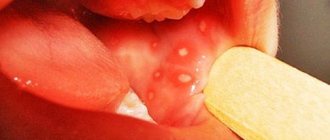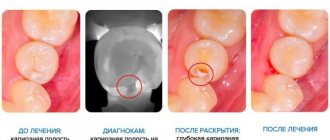Author of the article:
Soldatova Lyudmila Nikolaevna
Candidate of Medical Sciences, Professor of the Department of Clinical Dentistry of the St. Petersburg Medical and Social Institute, Chief Physician of the Alfa-Dent Dental Clinic, St. Petersburg
Caries in the stain stage is the initial stage of the disease, during which the tooth looks almost completely healthy, nothing bothers the person, and the process of destruction of dental tissue has already begun. In most cases, at this stage, no external damage to the tooth is visible, the tooth does not react to touch, but a barely noticeable light spot appears on the enamel. Also, the enamel becomes dull, loses its shine and becomes loose.
The spot at the initial stage is characterized by a small size and whitish color. Then, over time, its size increases, the enamel becomes loose and porous, and the stain darkens.
Causes of early stage caries
The initial stage of the disease is caused by microbes that live in the mouth, food debris stuck between the teeth, plaque and poor oral hygiene. All this is the reason for the contamination of the area with microorganisms.
Over time, calcium in the mouth is washed away from the tooth enamel, causing it to become brittle and porous. This process is called demineralization (loss of minerals), and the resulting spots are called areas of demineralization.
Quite often, these spots are located on the cervical area of the tooth, which is why they are practically invisible visually, and the person does not even realize that there is something wrong with the tooth. And in most cases, enamel caries in the stain stage is discovered only when the patient goes to the dentist with complaints about other teeth.
However, on the front teeth, both upper and lower, the onset of caries can still be seen even at home. To do this, you should brush your teeth, dry them and look in the mirror. If white spots are visible on the teeth, caries is present in the oral cavity.
A photo of the initial stage indicates that due to the similarity of shades of carious stains and tooth enamel, it is quite difficult to diagnose the onset of the disease. But if this succeeds, then with almost one hundred percent probability it can be said that the crystalline structure of tooth enamel can be restored with the help of mineral components coming from outside. If the carious spot has acquired a dark shade, then the enamel can be restored only if the process of destruction of hard tissues has not gone too far.
Should I go to the dentist?
Recently, my old friend from Rogachev (the city where I grew up) called me and said that her husband had a white spot on his tooth. I advised her husband to go to the dentist. “Or maybe I should just brush my teeth better and the stain will go away on its own? Or maybe there is some gel that can be used at home?” she doubted. Unfortunately, brushing your teeth, even the most thorough, will no longer help during the staining phase. As an additional prevention, you can use remineralizing gels. They enrich tooth enamel with minerals and protect teeth from acids. But I strongly recommend that you consult a dentist who can help you choose the right remineralizing agent for you.
Make an appointment +375 29 604-61-61
Caries in the spot stage: diagnosis
The simplest diagnostic method consists, as already noted, in drying the enamel and visual inspection. On dry teeth, demineralized areas appear dull, while healthy parts of the tooth are shiny.
But the most effective and reliable diagnostic method is to check the condition of tooth enamel using various organic dyes. For this, modern dentists can use:
- methylene blue (most often used);
- carmine;
- methylene red;
- tropeolin.
To identify the presence or absence of the disease, as well as determine the stages of development of dental caries, you must first remove plaque from the tooth, rinse it with a solution of hydrogen peroxide, then isolate it from saliva. To do this, the dentist uses cotton wool rolls, a saliva ejector and a stream of air. After this, the doctor applies a dye solution to the surface of the tooth, waits for a while, rinses with water and evaluates the result. If the enamel in any area becomes discolored, it means that caries is beginning to develop on the tooth.
In addition, the dentist probes the patient’s carious spot. In this case, a rough surface on part of the tooth will indicate caries.
It is most difficult to detect the disease at the initial stage in hard-to-reach areas of the jaw, for example, between the teeth. Most often, the disease is diagnosed there only at the stage of formation of a carious cavity.
It is important to distinguish between caries in the white spot stage and endemic fluorosis, a disease associated with an excess of fluoride in the body. The main difference between these diseases, which are similar in their manifestation, is that the stain is usually single, but fluorous spots are paired (located on the teeth of the same name) or multiple. In addition, these spots are more typical for incisors and canines, and early caries can affect any teeth, especially in the cervical area, as well as in the fissure area. Endemic fluorosis is most likely to occur in those who live in areas where drinking water contains a lot of fluoride.
Caries of enamel, dentin, cement
In dentistry, there are several classifications of caries depending on the affected area, the degree of disease activity and the depth of the lesion. The classification of the World Health Organization (WHO) is considered the generally accepted and most popular. According to it, the disease is divided into:
- enamel caries - superficial caries of dental tissue;
- Dentin caries - damage to the tooth tissue under the enamel;
- Cement caries is a root lesion that occurs after exposure of the tooth root.
If caries on tooth enamel can be stopped using non-invasive or minimally invasive methods, then it will no longer be possible to cure later stages without surgical intervention.
Treatment of caries in the spot stage
There are several treatment methods for the initial stage.
- Treatment with solutions of calcium and sodium - the Borovsky-Leus method. This method of combating incipient caries was very common several years ago; today it is used less frequently, primarily due to its toxicity. The technique includes cleaning the tooth from plaque using a professional abrasive paste, treating it with hydrogen peroxide and special solutions. First, use a solution of calcium gluconate, and then make lotions with a solution of sodium fluoride. You need to repeat the procedure 15-20 times. It is advisable to treat the tooth every other day.
- Gel applications. Damaged teeth are cleaned, after which a special heated gel containing agar-agar and sodium fluoride is applied to them. It hardens on the teeth in the form of a film and saturates the enamel with minerals. The course of treatment includes 5 applications. Recently it has also been used infrequently.
- The use of special calcium phosphate-containing gels, fluoride-containing varnishes (fluoride varnishes) and other preparations for remineralization of enamel.
- Filling. The dentist cleans the tooth surface from plaque, prepares the enamel by drilling, isolates the tooth from saliva, applies acid and a special adhesive to ensure reliable adhesion of the tooth surface to the filling, and only then fills the tooth and grinds the filling.
In addition, the dentist teaches the patient proper oral hygiene: he tells how to properly care for his teeth, how to clean them and how to eat. And he strongly recommends visiting the dental clinic in a few months.
Treatment
The stages of treatment of dental caries are generally similar to the stages of treatment of ordinary caries:
- excision of affected tissue;
- treatment with medicinal and antiseptic drugs;
- the root is filled to recreate the shape.
The difference arises in the difficulty of accessing the site of the disease. First you need to clean the pocket and expose the root. As a rule, treatment takes place in two steps - on the first day, carious tissue is removed and the cavity is filled with a temporary glass ionomer filling. At the second appointment, the doctor examines the gums for healing and installs a permanent filling. To treat cement caries, Family Dentistry uses materials that are not affected by saliva, blood and gingival fluid - composites and glass ionomers.
If cement caries is not treated, pulpitis and periodontitis may develop, which will lead to tooth loss. To avoid such consequences, you should visit the dentist once every six months. During the consultation, the doctor will be able to detect signs of caries and, with little effort, get rid of this problem.
Caries in the spot stage: treat at home
Unfortunately, carious lesions cannot be cured with folk remedies. To eliminate them, you need to contact your dentist. Caries in the spot stage can be cured with the help of professional hygiene and special remineralizing therapy.
An effective assistant in the fight for dental health will be remineralizing gels, pastes with fluoride and calcium, which must be alternated. For example, ASEPTA PLUS REMINERALIZATION paste will satisfy the enamel’s need for calcium, slowing down the development of carious processes.
Popular traditional methods of treatment can rather be attributed to measures to prevent this problem.
- Onions are considered an effective remedy with anti-inflammatory and antibacterial properties. Freshly squeezed juice from this vegetable can be used both to prevent caries and to get rid of toothache. To do this, you need to get juice from onions, moisten cotton wool with it and apply it to the sore tooth for several hours. If you don’t like the taste of onion juice, you can use a decoction of onion peels. To do this, you need to pour boiling water over the husk, let it brew and rinse your mouth three times a day.
- A vodka tincture of calamus root can also help in the fight against the initial stage of caries. To prepare it, you need to grind the root of the plant, add vodka and let it brew for a week. It is better to rinse with this solution before going to bed for one to three minutes. To enhance the bactericidal effect, you can add alcohol tincture of propolis to the calamus tincture.
- Chinese lemongrass also has an antibacterial effect. You can drink tea with this plant after holding it in your mouth, or you can rinse your mouth with it.
- Sea salt, a solution of which you need to rinse your mouth, can also prevent development.
- But, perhaps, propolis is considered the most effective remedy. A piece of it can be placed on the tooth, pressed with a cotton swab and held for thirty minutes.
- It’s a good idea to brush your teeth with laundry soap. To do this, you need to prepare a fresh soap solution, brush your teeth and rinse thoroughly with water.
- Fir oil will not only stop the development of caries, but also relieve aching pain. It is necessary to moisten a swab with oil and apply it to the tooth.
- Camphor alcohol has a similar effect, which is used to lubricate the tooth or moisten a tampon and apply it to the diseased area.
If dental caries is in the white spot stage, during this period the disease is still practically undetectable. But at the same time, it responds well to treatment, so it is important to visit the dental clinic as often as possible in order to detect it in time.
Preventive measures for “white caries”
The main component of dental health and prevention of caries development is compliance with the rules of prevention:
regular and proper oral hygiene. It is necessary to brush your teeth not only with a brush, but also after each meal you should use dental floss. After removing pieces of food with a thread, it is advisable to chew chewing gum for 5 minutes;
- Maintain a nutritious diet and try to avoid frequent snacks between meals. A common cause of caries is frequent consumption of sweets, flour, candies, chips, fast foods, and carbonated drinks. For dental health, the diet should contain fish, vegetables, fruits, kefir, nuts, cottage cheese, milk and other products with a high content of fluorine, phosphorus and calcium;
- periodically carry out professional teeth cleaning and treat the enamel with fluoride-containing preparations.
If you follow these basic rules, you can keep your teeth strong and healthy. But in order to avoid complications and prevent the pathology from becoming severe, you need to regularly visit the dentist and, if necessary, carry out proper and effective treatment of caries in the spot stage.
Prevention
How to protect yourself from caries?
- rinse your mouth after eating with Asepta Fresh (you can use chewing gum, but always without sugar);
- use dental floss, forgetting about toothpicks;
- choose the toothpaste wisely and change the brush more often;
- strengthen your immunity;
- take vitamins;
- take care of a balanced diet;
- no smoking;
- avoid stress.
Sources:
- Report on the determination/confirmation of the preventive properties of personal oral hygiene products “ASEPTA PLUS” Remineralization doctor-researcher A.A. Leontyev, head Department of Preventive Dentistry, Doctor of Medical Sciences, Professor S.B. Ulitovsky First St. Petersburg State Medical University named after. acad. I.P. Pavlova, Department of Preventive Dentistry
- Report on determining/confirming the preventive properties of toothpaste “ASEPTA PLUS” COFFEE and TOBACCO Author: doctor-researcher A.A. Leontyev, head Department of Preventive Dentistry, Doctor of Medical Sciences, Professor S.B. Ulitovsky. First St. Petersburg State Medical University named after. acad. I.P. Pavlova, Department of Preventive Dentistry
- The role of anti-inflammatory rinse in the treatment of periodontal diseases (L.Yu. Orekhova, A.A. Leontyev, S.B. Ulitovsky) L.Yu. OREKHOVA, Doctor of Medical Sciences, Prof., Head of Department; A.A. LEONTIEV, dentist; S.B. ULITOVSKY, Doctor of Medical Sciences, Prof. Department of Therapeutic Dentistry of St. Petersburg State Medical University named after. acad. I. P. Pavlova
Infiltration - protecting enamel from bacteria
Infiltration therapy for initial caries is suitable for adults and children over three years of age. It is safe and painless, but during the procedure you will have to sit quietly in the dentist's chair for about 20 minutes. For most young children this is an overwhelming task.
Infiltration technology was invented in Germany, it has European certification and has been used abroad for a long time. In our country, the ICON method has become popular relatively recently.
What is the essence of the method. Tooth enamel has a porous structure. When bacteria penetrate the pores, intense destruction of dental tissue occurs. During the procedure, the dentist applies several compounds to the teeth in a certain sequence. The last of them acts as a sealant and seals the enamel pores. This prevents bacteria from penetrating deep into the tooth, and the carious process stops. The big advantage of this method is that the treatment is performed in one procedure and gives excellent results.
How is diagnostics carried out?
If we are dealing with a closed location of the disease focus, then the specialist will need to carry out additional procedures for a thorough diagnosis:
- cleaning of dental plaque: removal of subgingival and supragingival plaque and stone to clean the inspection area. For this purpose, manual methods, ultrasonic equipment or, for example, the Air Flow system can be used,
- protection of the root from contact with saliva: a rubber dam (special latex plate) is the most effective option for isolating the root from saliva and creating comfortable conditions for the examination,
- probing: a sharp probe (an instrument with a hook) is used, which, based on its rough surface, is able to distinguish normal tissue from damaged tissue,
- X-ray examination: allows you to diagnose even minor gingival defects in places that are difficult to access.
In order to diagnose caries in an advanced stage, that is, hidden under the gum, a visiograph is often used - a special device that transmits information to a computer and allows you to view the identified defect in an enlarged format and from different angles.
What does caries look like under a microscope?
Caries looks very interesting under a microscope, especially if you look at it on a tooth cut. Below you can see what superficial, medium and deep forms of caries look like. In addition, in each photograph in the center of the tooth crown you can see the cavity (pulp chamber) in which the neurovascular bundle of the tooth is located.
Dental caries is...
Dental caries (lat. caries dentis) is a complex, slow-moving pathological process that occurs in the hard tissues of the tooth (dentin with a cavity, covered on the outside with enamel and cement). Dentin (lat. dentinum) is the hard tissue of the tooth, making up its bulk in the area of the crown, neck and root. The coronal part is covered with enamel, the root part of the dentin is covered with cement. Dentin in its structure is a crystallized material that contains 70% inorganic substances, 20% organic substances and 10% water.
Complications
Untimely treatment of caries leads to inevitable complications:
- development of pulpitis (the carious process gradually spreads to the deep layers of dentin surrounding the pulp of the tooth);
- if pulpitis is not treated, necrosis of the pulp occurs (i.e. it dies), as a result, a focus of inflammation appears at the apex of the tooth root;
- development of gum “flux” (a purulent process occurs between the jaw and periosteum);
- the appearance of a cyst at the apex of the tooth root (the bone tissue is resorbed, and inflammation forms in its place).
Installation of a filling for initial caries
Treatment of initial dental caries in most situations does not require the use of a drill, but in some cases filling is performed. This usually occurs at the dark spot stage, when the doctor is not confident in the success of remineralizing therapy, and for some reason treatment using Icon technology cannot be carried out. Light filling for initial caries is considered the most effective, since it has high functional and aesthetic indicators.











